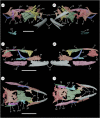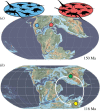A Morrison stem gekkotan reveals gecko evolution and Jurassic biogeography
- PMID: 38018104
- PMCID: PMC10685121
- DOI: 10.1098/rspb.2023.2284
A Morrison stem gekkotan reveals gecko evolution and Jurassic biogeography
Abstract
Geckos are a speciose and globally distributed clade of Squamata (lizards, including snakes and amphisbaenians) that are characterized by a host of modifications for nocturnal, scansorial and insectivorous ecologies. They are among the oldest divergences in the lizard crown, so understanding the origin of geckoes (Gekkota) is essential to understanding the origin of Squamata, the most species-rich extant tetrapod clade. However, the poor fossil record of gekkotans has obscured the sequence and timing of the assembly of their distinctive morphology. Here, we describe the first North American stem gekkotan based on a three-dimensionally preserved skull from the Morrison Formation of western North America. Despite its Late Jurassic age, the new species already possesses several key characteristics of the gekkotan skull along with retained ancestral features. We show that this new stem gekkotan, and several previously named species of uncertain phylogenetic relationships, comprise a widespread clade of early crown lizards, substantiating faunal homogeneity in Laurasia during the Late Jurassic that extended across disparate ecological, body-size and physiological classes.
Keywords: Gekkota; Squamata; biogeography; macroevolution; phylogenetics.
Conflict of interest statement
The authors declare no competing interests.
Figures





Similar articles
-
Fossil-informed biogeographic analysis suggests Eurasian regionalization in crown Squamata during the early Jurassic.PeerJ. 2024 Apr 30;12:e17277. doi: 10.7717/peerj.17277. eCollection 2024. PeerJ. 2024. PMID: 38708352 Free PMC article.
-
Evolutionary origins of the prolonged extant squamate radiation.Nat Commun. 2022 Nov 29;13(1):7087. doi: 10.1038/s41467-022-34217-5. Nat Commun. 2022. PMID: 36446761 Free PMC article.
-
Low rate of interchromosomal rearrangements during old radiation of gekkotan lizards (Squamata: Gekkota).Chromosome Res. 2015 Jun;23(2):299-309. doi: 10.1007/s10577-015-9468-6. Epub 2015 Feb 11. Chromosome Res. 2015. PMID: 25665924
-
At the feet of the dinosaurs: the early history and radiation of lizards.Biol Rev Camb Philos Soc. 2003 Nov;78(4):513-51. doi: 10.1017/s1464793103006134. Biol Rev Camb Philos Soc. 2003. PMID: 14700390 Review.
-
A new fossil from the Jurassic of Patagonia reveals the early basicranial evolution and the origins of Crocodyliformes.Biol Rev Camb Philos Soc. 2013 Nov;88(4):862-72. doi: 10.1111/brv.12030. Epub 2013 Feb 28. Biol Rev Camb Philos Soc. 2013. PMID: 23445256 Review.
References
-
- Kluge AG. 1967. Higher taxonomic categories of gekkonid lizards and their evolution. Bull. Am. Mus. Nat. Hist. 135, 1-60.
-
- Gauthier JA, Kearney M, Maisano JA, Rieppel O, Behlke ADB. 2012. Assembling the squamate tree of life: perspectives from the phenotype and the fossil record. Bull. Peabody Mus. Nat. Hist. 53, 3-308. (10.3374/014.053.0101) - DOI
MeSH terms
LinkOut - more resources
Full Text Sources
Other Literature Sources

